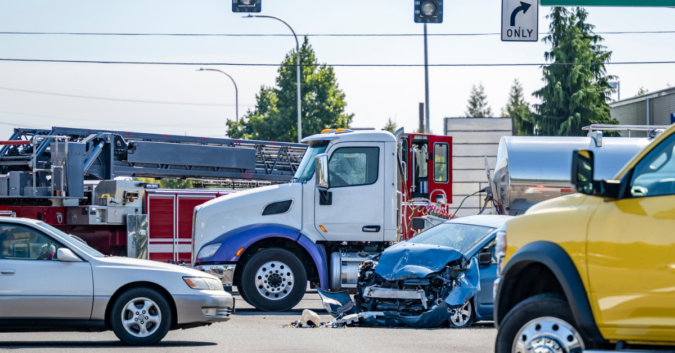According to the National Highway Traffic Safety Administration (NHTSA), there were 4,102 deaths in accidents involving commercial vehicles in 2017, marking a 52% increase from 2009.
As the U.S. population grows, American roads are packed with more cars and trucks than ever before. Accordingly, each year, the number of roadway accidents involving commercial vehicles — such as big rigs, box trucks, coach buses, and cargo and delivery vans — continues to rise.
On average, the Federal Motor Carrier Safety Administration (FMCSA) estimates roughly 550,000 accidents involving trucks occur each year.
In recent years, this worrying trend has only continued to increase, fueled by factors like the COVID-19 pandemic, changing consumer trends, and increases in online shopping.
More Consumers, More Cargo, More Trucks
According to the U.S. Census Bureau, there are currently more than 3.5 million truck drivers in the United States — a figure that does not include other large-vehicle drivers such as those who operate buses and cargo and delivery vans.
Each year, commercial trucks in the United States travel a collective total of 450 billion miles, moving roughly 11 billion tons of merchandise from ports to factories to warehouses to stores and, ultimately, to consumers.
The American Trucking Associations (ATA) estimates roughly 72% of all consumer goods are moved by trucks, making the industry worth more than an estimated $800 Billion per year.
In late 2021 and early 2022, the world experienced a global supply-chain crisis due in large part to pandemic-related lockdowns and clogged shipping ports. Major U.S. roads and highways — especially those near ocean ports — grew intensely “bottlenecked” with traffic lanes packed full of backed-up semi-trucks looking to move out of coastal shipping ports.
Now, as the United States continues to emerge from the global supply chain crisis, the number of trucks on highways and roads remains at an all-time high. This abundance of commercial vehicles can lead to dangerous driving conditions for drivers of ordinary passenger vehicles.
More Trucks, More Deadly Accidents
A major factor in deadly commercial vehicle crashes is truck-driver fatigue, which is responsible for roughly 13% of all large truck accidents each year, according to the National Academy of Sciences. The pandemic’s supply-chain crisis has only increased the levels of fatigue many truck drivers experience.
During the pandemic, tens of thousands of truck drivers — especially those who drive long distances (commonly referred to as “over-the-road” truck drivers) — have been subjected to exceedingly long hours, making driver fatigue a regular side effect of the job.
On top of truck driver fatigue, many experts believe the trucking industry itself, including the companies that own trucks and fleets, also shoulders a large portion of the blame for the notable uptick in crashes involving commercial vehicles.
Companies that buy commercial vehicles and the insurance providers that insure them are driven by a never-ending pursuit of profit. Accordingly, such companies may skimp on safety measures and vehicle upkeep, and avoid or delay purchasing new technologies that could make trucks safer for all drivers on the road.
In addition, these companies all too often incentivize dangerous truck driving, by motivating truck drivers with bonuses and other pay- and wage-related incentives for meeting or beating delivery deadlines.
As a result of these factors and more, FMCSA estimates more than 5,000 drivers and pedestrians die in commercial vehicle crashes each year.
Given their sheer size and weight, a commercial vehicle has a far greater likelihood of causing severe or deadly injuries to ordinary passenger vehicle drivers.
What to Do If You Were in an Accident With a Commercial Vehicle
As American roads and highways grow more congested with vehicles, the average driver’s chance of being involved in a serious or fatal truck accident also increases. In fact, the World Health Organization (WHO) believes car crashes will become the 5th-leading cause of death by the year 2030.
There are big differences between a commercial truck accident and passenger vehicle accident. The chance of a catastrophic or fatal injury increases drastically when a commercial vehicle is involved.
On average, large commercial vehicles cost companies between $120,000-200,000 to purchase and are very expensive to maintain and insure. Given this, when a large truck accident occurs, companies will seek to minimize any resulting damages, injuries, or deaths.
Without legal expertise and experience, it’s difficult for ordinary citizens to hold such large enterprises and their insurers accountable after a serious, costly, or deadly accident.
If you or a loved one was seriously injured — or killed — in a commercial vehicle accident involving a big rig, coach bus, delivery van, or dump truck, it’s in your best interest to seek legal assistance right away.
After sharing the details of your situation, an experienced truck accident lawyer can determine whether you may be eligible to file a lawsuit.
As a well-established national truck accident law firm, Sokolove Law has the resources to hold negligent drivers accountable for the injuries they may have caused you and your family. Over the last 45+ years, our firm has recovered more than $10 Billion for injured clients nationwide.
Get in touch with our team today to start your free, no-obligation legal case review.
